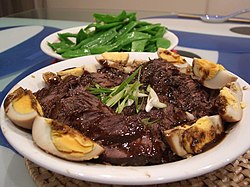Braising
This article needs additional citations for verification. (August 2007) |




Braising (from the French “braiser”) is a combination cooking method using both moist and dry heat; typically the food is first seared at a high temperature and then finished in a covered pot with a variable amount of liquid, resulting in a particular flavor. Braising of meat is often referred to as pot roasting, though some authors make a distinction between the two methods based on whether additional liquid is added.[1][2]
Method
Braising relies on heat, time, and moisture to break down the tough connective tissue collagen in meat, making it an ideal way to cook tougher cuts. Many classic braised dishes such as coq au vin are highly evolved methods of cooking tough and otherwise unpalatable foods. Pressure cooking and slow cooking (e.g., crockpots) are forms of braising.
Techniques

Most braises follow the same basic steps. The food to be braised (meat, poultry, but also vegetables or mushrooms) is first seared to brown its surface and enhance its flavor (through the Maillard reaction). If the food will not produce enough liquid of its own, a small amount of cooking liquid that often includes an acidic element, such as tomatoes, beer, or wine, is added to the pot, often with stock. Classically a braise is done with a relatively whole cut of meat, and the braising liquid will cover 2/3 of the product. Then, the dish is covered and cooked at a very low simmer until the meat is fork tender. Often the cooking liquid is finished to create a sauce or gravy.[3][4]
Sometimes foods with high water content (particularly vegetables) can be cooked in their own juices and no extra liquid is required.[5]
A successful braise intermingles the flavors of the foods being cooked and the cooking liquid. This cooking method dissolves collagen from the meat into gelatin, to enrich and add body to the liquid. Braising is economical, as it allows the use of tough and inexpensive cuts, and efficient, as it often employs a single pot to cook an entire.
Braised foods
Familiar braised dishes include pot roast, Swiss steak, chicken cacciatore, goulash, Carbonade Flamande, coq au vin, sauerbraten, beef bourguignon and Moroccan tajines, among others. Braising is also used extensively in the cuisines of Asia, particularly Chinese cuisine[6] and Vietnamese cuisine, where soy sauce (or in Vietnam, soy sauce and fish sauce) is often the braising.
See also
References
- ^ "Pot-Roasting". Food Resource. College of Health and Human Sciences, Oregon State University. Retrieved March 30, 2009.
- ^ "Braise". Food Resource. College of Health and Human Sciences, Oregon State University. Retrieved March 30, 2009.
- ^ Buford, Bill (2006). Heat. New York, NY, USA: Alfred A. Knopf. pp. 70–75. ISBN 978-1-4000-4120-6.
- ^ Colicchio, Tom (2000). Think Like a Chef. Clarkson-Potter. pp. 52–63. ISBN 978-0-609-60485-4.
- ^ Courtine, Robert J.; et al., eds. (1988) [French edition published 1984]. Larousse Gastronomique (English ed.). Paul Hamlyn. p. 133. ISBN 0-600-32390-0.
{{cite book}}: Explicit use of et al. in:|editor1-first=(help) - ^ Tropp, Barbara (1996). The Modern Art of Chinese Cooking. William Morrow Cookbooks. ISBN 978-0-688-14611-5.


